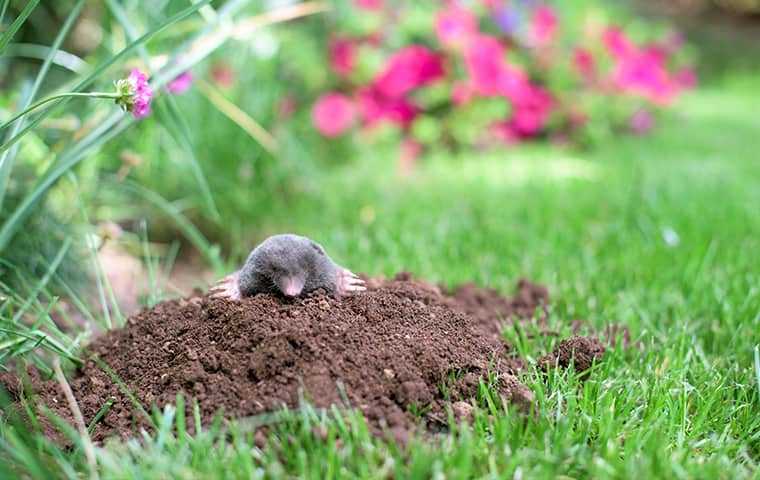
How to Repel Moles
Mole problems can appear overnight. When they do, homeowners often run to over-the-counter mole solutions. While mole control products can work, they often don't, and when they fail, the moles in your yard can grow a family (or several families) and destroy your lawn in a couple of weeks.
If you don't have a mole problem at the moment, you'll find some helpful tips in this article. If you're currently battling a mole problem, we know where you can find effective mole control in San Diego County. Contact HomeShield Pest Control. We use humane mole pest control to address mole problems.
Jump to our contact page and reach out to us. We are your San Diego County pest control experts. In either case, read on to learn how to tell whether or not you have moles in your yard, what attracts moles, how to repel them naturally, and the best way to control moles.
How To Tell If You Have A Mole In Your Yard
You're not likely to see moles above ground the way you might see a gopher, which is a little bit of a bummer. When you see a gopher waddling through your yard, you don't have to wonder if you have a gopher problem. Since moles don't do this, you'll have to look for evidence to help you determine whether or not you're dealing with moles. The good news (or bad news) is that moles will make an unsightly mess of your yard and let you know that you have a problem. Let's discuss how you can tell that moles are causing the damage.
Moles often tunnel near the surface of the ground. You're likely to see their raised tunnels. They look like veins, lightning, a tree branch, or rivers. Some mole tunnels are slight and may not have a raised appearance. Look for dead grass on top of the tunnels. Moles damage the roots of turfgrass as they tunnel through your yard. These dead pathways may run into larger blobs of dead grass as moles often come into yards to eat grubs.
Moles create piles of dirt as they make tunnels through your yard. They push all the dirt up and out of their tunnels like a bulldozer. Because they do this, the dirt will be clumpy.
Moles aren't the only pests that make mounds in yards, so you'll have to examine the mounds and look for characteristics that distinguish them from the mounds of other pests, such as gophers and cicada killer wasps. Yes, wasps can make large mounds of dirt in your yard. It is strange but true.
Mole mounds are volcano-shaped or look like a big mound of dirt with a plug on top. You'll have to look closely to see the plug because the plugs often blend in.
Once you have determined that you do, indeed, have moles in your yard, the next step is to consider what to do about them. You may skip to the last section of this article to find out. If you don't have moles yet, the next two sections could help you keep them out of your yard.

What Kinds Of Things Attract Moles To Your Yard?
A mole doesn't need a reason to come into your yard. They are common pests that can plague any yard no matter what conditions are present. But they do have preferences. If moles find what they're looking for in your yard, you have a greater chance of them stick around.
- Grubs - Mole problems often begin with grub problems. Grubs are the larvae of beetles. When beetles lay eggs in your yard, grubs can start to damage your lawn. It is important to address grubs early to prevent moles from moving in.
- Earthworms - A healthy lawn can have a lot of earthworms in it. You should not be surprised to find moles moving into your yard even though it is beautiful, lush, and green.
- Other lawn pests - Moles eat a wide assortment of insects, including the insect that bears its name: The mole cricket.
- Moisture - You can attract a mole to your yard by overwatering your grass. In the soil of a moist lawn, there will be more worms. But, when moisture turns into oversaturation, it can drive moles out.
- Drought - You can attract moles by having a dry lawn. Dry conditions can promote insect activity and moles eat insects by the truck load.
- Loamy soil - Loam is a mixture of sand, silt, and clay. Plants grow well in loamy soil, so gardeners and folks with a green thumb prefer it. Moles also prefer it.
While you won't get 100 percent protection from moles if you address mole attractants, you should take steps to address these issues. An ounce of prevention is worth a pound of cure.
How To Repel Moles Naturally
Along with removing attractants, such as applying products for mole and grub control, some residents turn to repellents to keep moles away. The chief issue with repellents is that there is no scientific evidence that they work.
People put all sorts of things inside mole holes, such as razor blades, broken glass, mothballs, bleach, lye, and thorny rose bush branches to drive moles away. They install devices to scare moles, such as mole wheels, whistling bottles, vibrating windmills, and electrical devices that vibrate the soil. None of these methods have proven to be successful. Moles find a way around them and sometimes just ignore them.
One repellent method has shown itself to be effective at driving moles away: An application of repellents containing castor oil. These products have a track record of success in the Eastern United States but are not yet known to work on the species of moles we have here in the West. More research is needed. But, even if repellents with castor oil work, are they the best way to address a mole infestation? If you manage to drive moles out of your yard, what are those moles going to do? They'll reproduce, grow a family, and send their offspring back into your yard.
The best solution is to humanely stop moles on your property and arrest mole activity on and around your property. We can help you with this.
How Professionals Can Help With Mole Control
Trapping is a common control method used by pest professionals. Some professionals trap and remove moles while others use traps to exterminate moles. Trapping can be effective for mole control, but some aren't nearly as humane as other control methods.
At HomeShield Pest Control, our goal is to provide humane solutions to address pest concerns. We primarily use three treatment solutions for San Diego County moles.
- We use carbon monoxide treatments to put moles to sleep, then they remain in the ground to decompose. The carbon monoxide gas is a smoke. We pump this smoke into the mole tunnels and trap the gas inside. The smoke is visible, which allows our technicians to locate exit holes on your property and plug them. CO2 treatments are Controlled Atmosphere Treatments. Carbon monoxide is found in the atmosphere, so it is 100 percent environmentally friendly. It won't harm your plants or give the vegetables in your garden a bad taste. In fact, your plants love CO2. When your treatment is done, there will be no residual left behind and no more mole activity in your yard. It is as simple as that.
- We use a unique baiting formula to draw moles away from gardens, flowers, landscape vegetation, shrubs, and other areas where damage can occur. We also apply bait strategically in mole runs throughout your property. The trick to effectively baiting moles is to provide a food source they recognize. Some over-the-counter baits come in a peanut shape. Since moles don't eat peanuts, they don't eat the bait. The experts on staff here at HomeShield Pest Control understand the food preferences and behavior patterns of these animals and we use this knowledge to outsmart them.
- Along with control products, we use Integrated Pest Management methods to alter conditions that promote mole activity. A process of inspections, treatments, evaluations, and pest maintenance work together to prevent future mole infestations.
Have you had all you can take from moles? Do you want to get moles out and keep them out? We offer long-lasting solutions to arrest mole activity as permanently as possible.
If you're In San Diego County, reach out to HomeShield Pest Control today for more information or to request a pest inspection. We'll take a look at what you're up against and guide you toward the right solution for your specific issue and help you get your services within your budget.
No job is too big and no job is too small. Our technicians always bring their A-game, and we come ready to do the hard work necessary to give you the highest level of service. Connect with us today.

Our Pest Control Services
We Provide Reliable Home Pest Control And Commercial Pest Control Solutions.
Why Our Customers Love Us
HomeShield Pest Control received an average rating of 5.0 out of 5 stars from over 8000+ reviews.
-
Homeshield was great to work with!“Homeshield was great to work with! My wife and I encountered a really bad termite problem at our new home during the renovation phase, and needed treatment asap so that renovation could resume. Mike drove all the way down for an inspection, and was very thorough in his explanations. He was able to match a competitor's price for the treatment and locked in a day for the following week. Daniel and Elias, the technicians, were very communicative about their ETA and did a good job explaining their respective roles. All in all, a quick and easy process. Thank you, Homeshield!”- James Y.
-
Pleasant, friendly and respectful.“Bronson announced his arrival and departure. He inquired if there was anything specific that we wanted done prior to him starting his regular service. Pleasant, friendly and respectful.”- Joseph S.
-
Will continue using homeshield!“
Amazing work! Switched from Terminex as I was tired of having scheduling issues and wanted something eco friendly for my dogs and upcoming baby.
”
I definitely recommend trying to get Jose Garcia as your technician as he was very communicative and kept us updated throughout the service process.
Will continue using homeshield!- Chris P.M. -
Humble and helpful. Does what ever we are asking for.“You guys provide very quality service. We are very happy with the service. Every time the person comes to our place to provide service is very humble and helpful. Does what ever we are asking for. Thank you.”- Arif S.
-
Excellent experience. Super professional and thorough“
Excellent experience. Super professional and thorough. Found them through yelp and they called immediately with affordable options and set up an appointment. The technician was wonderful. Would highly recommend.
”- Samantha S. -
Quote came within minutes and price was very reasonable.“
Dee provided a very thorough and detailed inspection. Walked us through the entire process and what we could expect throughout the initial services and beyond. Quote came within minutes and price was very reasonable.
”- Jason D. -
Ben was FANTASTIC“
Ben was FANTASTIC in every way, He came to give me an estimate on my home, was on time, polite, knowledgeable, and extremely professional in how he handled everything. Had 4 other termite co. to give me an estimate, not even close to Ben's expertise, I would give him a 10 if I could. Will definitely use him in all my other projects , they are a lot since I am in real estate and have many clients.
”- Judy M. -
Victor, was very professional, helpful and informative.“
We had a great experience. They were able to work with our schedule to make a quick appointment. The service professional, Victor, was very professional, helpful and informative.
”- Mark S.

Featured On







.svg.2405150737550.png)






